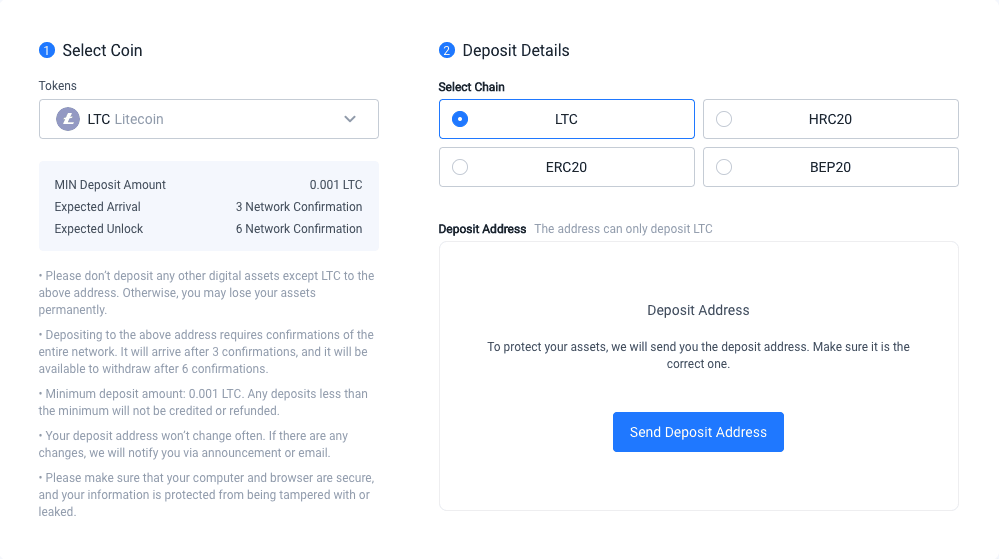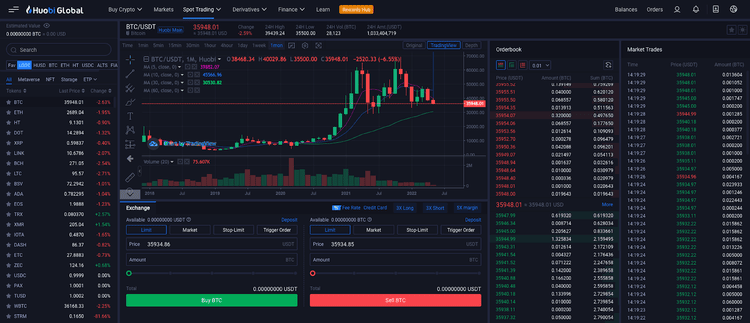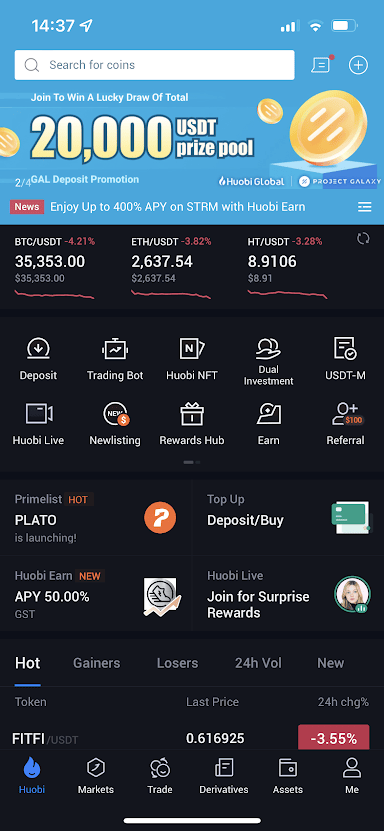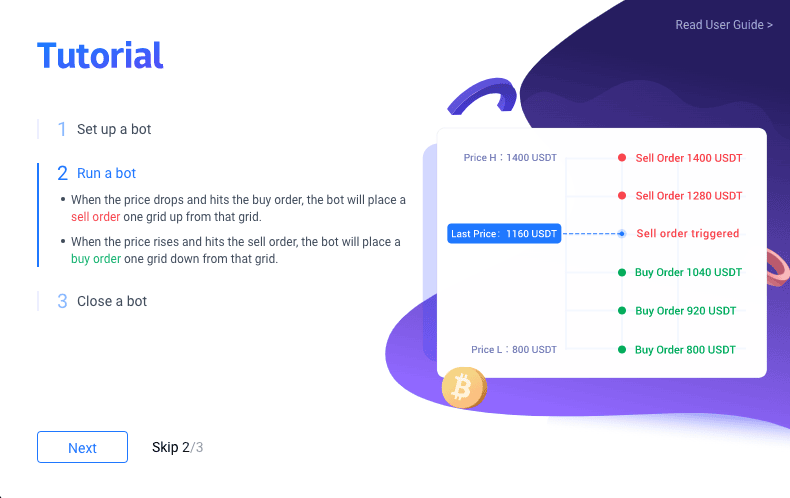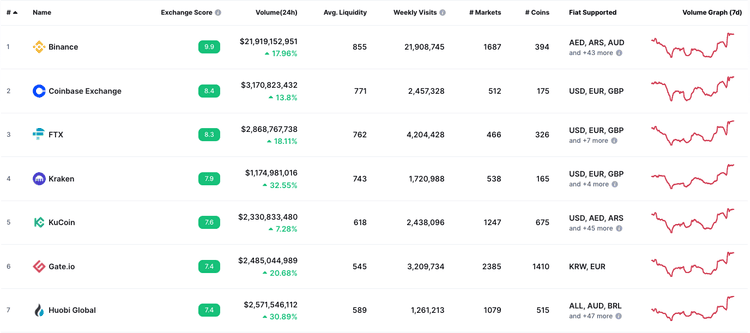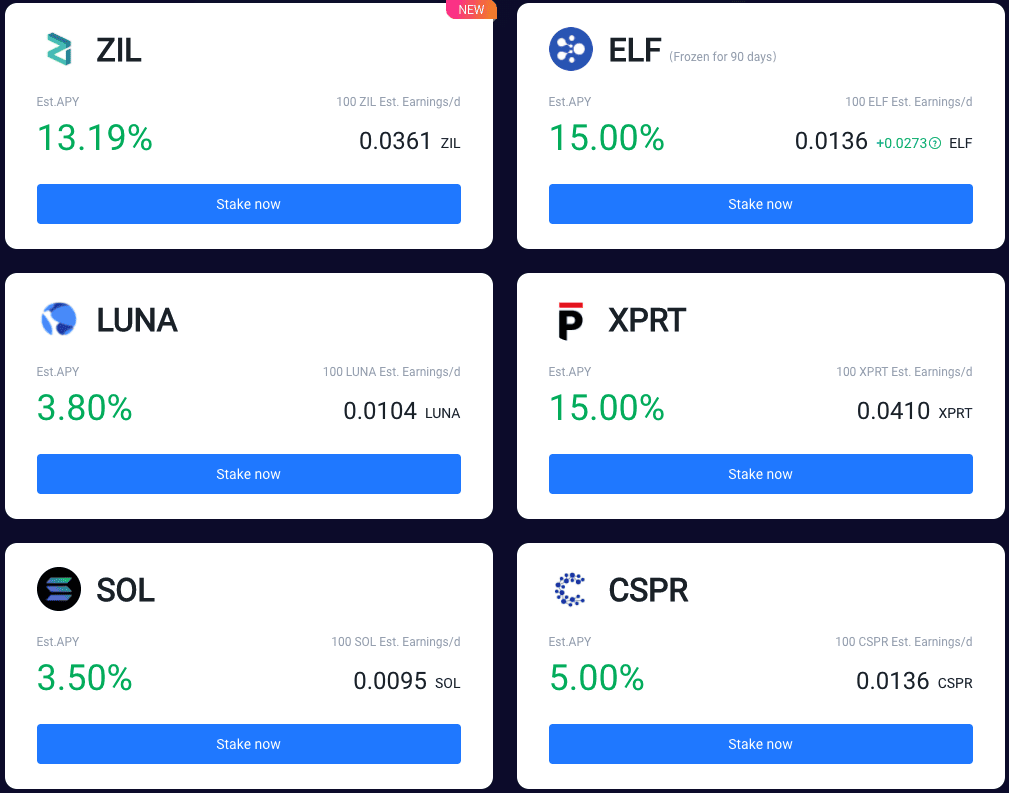Huobi Global Overview
Introduction
Founded in China in 2013 and now based out of Seychelles, Huobi is one of Asia’s biggest crypto exchanges. It has offices in Hong Kong, South Korea, Japan, and the U.S. Following regulation hurdles and an outright ban on cryptocurrency in China, Huobi ceased all of its Chinese operations in 2021. Despite this, it still boasts more than 10 million users and is ranked 7th on CoinMarketCap’s best exchange list.
Huobi initially developed its crypto exchange to target the more adept and professional trader, offering an advanced platform and U.I. with a comprehensive list of advanced tools. It had recently added Huobi Lite to its offering as a conduit for beginners into the crypto market. But, following technical issues at the time of writing this review, Huobi Lite was removed from the Huobi Global mobile app and therefore unavailable indefinitely.
Like China, U.S. citizens are also prohibited from using Huobi.
Is Huobi Safe?
With the sheer volume of cryptocurrency and crypto assets flowing through crypto exchanges, it’s no surprise that they are big targets for hackers and criminals. Every successful exchange employs numerous security features to ensure no fraudulent activity, and Huobi is no different. We can always tell a lot about an exchange’s security by looking at its breach history, and we couldn’t find any evidence to suggest that Huobi has had any security breaches.
Huobi utilises multiple security measures, including Two-Factor Authentication (2FA) – One of the most essential steps in security. It is compulsory on the Huobi exchange, and Huobi uses Google Authenticator for deposits and withdrawals.
Huobi also uses cold wallet storage of assets and funds – offline wallets that hold most of its users’ funds. These wallets are highly secure and cannot be accessed by any hackers as they’re offline. Huobi keeps 98% of its assets in cold storage, and the other 2% is used on the exchange for liquidity purposes.
Huobi’s best security feature is its investor protection fund which has a total amount of 20000 BTCs. In basic terms, it’s a type of insurance in case of any security breach, making sure users get fully compensated if a breach occurs.
Huobi’s protection program is an excellent way to protect users’ funds. Rather than relying on an insurance company with a possibility of no payout, Huobi almost guarantees your money will get reimbursed following a possible security breach.
Getting Started
Assets & Pairs
Huobi has support for an impressive amount of assets. It has 597 cryptocurrencies and 1124 pairs listed, including the top 10 cryptocurrencies by market cap, including BTC, ETH, DOT, and XRP. It also lists an extensive array of stable coins like USDT, UST, and TUSD. Huobi has two native tokens, H.T. and HUSD.
Sign-up / Verification Process
Signing up with Huobi involved a couple of extra steps than we’re used to on other exchanges. There are two levels of KYC verifications, with each level having different limits attached to them. The first level involves uploading a copy of a preferred I.D. document. We usually find a driver’s license to be the most straightforward way to get your application processed quickly, though a passport is a valid option as well.
The first level of KYC verification lets you withdraw crypto up to a limit of 100 BTC per day and trade up to USD $300 per trade, or USD $1502 per day total. Unless you’re purely using Huobi to learn about cryptocurrency and gain some experience by trading small amounts, we don’t think this will be enough and recommend advanced verification.
The advanced KYC verification, which is accessed by providing a quick selfie with your I.D. document using a mobile phone or laptop camera, lets you trade with no single or daily limits. We, unfortunately, had to wait more than 36hrs for the advanced KYC verification to be verified, which meant we couldn’t deposit any fiat currency. This probably won’t be an issue if you’re in no rush, but we have had much faster KYC verification from most other exchanges we’ve reviewed.
Funding Methods
Huobi supports 57 local currencies and more than 60 fiat payment methods, depending on your location. You can also deposit crypto from an external source or Huobi’s crypto wallet. You’ll need to fully KYC verify your account and enable Google two-factor Authentication before you can deposit fiat currency.
Using fiat currency to buy crypto was pretty straightforward. Just head over to ‘Assets Overview’ by clicking on ‘Balances’ on the top right of your screen. Transfer, withdrawal, and deposit options can be found here, just navigate through each tab and follow the instructions.
Fiat deposits are free, but we also bought some crypto from the U.K. using a Visa card, and we were charged 3.5% for the transaction. Credit card fees are always high, and you should generally opt for a cheaper option like bank transfers if you intend to buy a lot. SEPA transfers are supported for European customers and Visa debit/credit cards, and the same fees apply. Although U.S. users are prohibited from using the service, you can still hold a USD fiat balance.
If you want to move your crypto to Huobi, it is very easy to fund your account by depositing crypto from an external wallet. You can do it all from the same deposit section as fiat currency, just navigate to the cryptocurrency tab and select which coin you wish to deposit. Minimum deposits vary, and deposit times are dependent on the network confirmations on the relevant blockchain. But, in our experience, deposit times are never typically longer than a few minutes, and in worst-case scenarios, up to a couple of hours.
Huobi’s minimum deposits are 0.0005 BTC, 1 USDT, 0.01 ETH, 0.1 XRP, and 0.001 LTC.
Withdrawals
Huobi supports both fiat and crypto withdrawals. Crypto withdrawals are subject to minimum limits and fees. The fees are dependent on the blockchain used, and limits are different for every coin. For example, for BTC, you will pay $12.74. The minimal withdrawal for BTC is 0.0014. To avoid all crypto withdrawal fees, Huobi makes it free to withdraw your crypto to its non-custodial wallet service. We’ve covered this in more detail in the wallet section of this review.
For fiat withdrawals, Huobi has different verification tiers with different limits attached. A complete list can be found here.
Fees
Huobi fees are simple. Most exchanges use a maker/taker fee structure, but Huobi uses a spot rate for all trades, with a discount applied for the more H.T. (Huobi Token) held in your account. For the average trader with a 30-day trading volume of under 1000 BTC, Huobi will charge you 0.2% per trade. Discounts start at 10% if you hold 10 H.T. and can get up to 65% if you hold 5000 HT or more. A full breakdown can be found below.
Normal Users
| Level | 30-Day Trading Volume In (BTC) | Base fee rate | HT holdings | Fee Rate (in HT) | Effective Discount |
|---|---|---|---|---|---|
| 1 | < 1000 BTC | 0.20% | ≥10HT | 0.18% | 10% |
| 2 | < 1000 BTC | 0.20% | ≥100HT | 0.16% | 20% |
| 3 | < 1000 BTC | 0.20% | ≥500HT | 0.12% | 40% |
| 4 | < 1000 BTC | 0.20% | ≥1000HT | 0.09% | 55% |
| 5 | < 1000 BTC | 0.20% | ≥2000HT | 0.08% | 60% |
| 6 | < 1000 BTC | 0.20% | ≥5000HT | 0.07% | 65% |
We find Huobi’s basic fees are higher than most of its direct competitors, like Binance and KuCoin, both having maker/taker fees of 0.1%/0.1%.
Professional Users
Huobi also caters to professional traders and uses a maker/taker fee structure. Starting at 0.362%/0.462% if you hold 700 BTC or more and 2000 H.T. or more. It can get down to as low as 0.0097%/0.0193% if you hold 100,000 BTC and 2000 H.T. A full breakdown can be found below.
| Level | 30-Day Trading Volume In (BTC) and HT holdings | Maker Fee | Taker Fee |
|---|---|---|---|
| 1 | > 700 BTC & > 2,000 HT | 0.0362% | 0.0462% |
| 2 | > 1,000 BTC & > 2,000 HT | 0.0294% | 0.0420% |
| 3 | > 3,500 BTC & > 2,000 HT | 0.0294% | 0.0378% |
| 4 | > 7,000 BTC & > 2,000 HT | 0.0252% | 0.0336% |
| 5 | > 10,000 BTC & > 2,000 HT | 0.0224% | 0.0308% |
| 6 | > 15,000 BTC & > 2,000 HT | 0.0210% | 0.0294% |
| 7 | > 30,000 BTC & > 2,000 HT | 0.0168% | 0.0252% |
| 8 | > 60,000 BTC & > 2,000 HT | 0.0126% | 0.0210% |
| 9 | > 100,000 BTC & > 2,000 HT | 0.0097% | 0.0193% |
The Platform
Platform & Ease of Use
Unfortunately, Huobi does not cater to beginner and intermediate traders. You can still use its desktop and mobile platform and probably won’t have too much of a hard time buying and selling crypto from Huobi’s Quick Buy/Sell menu, but we don’t recommend it. There are far more user-friendly and beginner platforms like Coinbase or Gemini.
We have used a beginner platform in the past from Huobi, called Huobi Lite, which was available on the mobile app. We couldn’t find anything online to explain why it’s no longer available, so we contacted customer support about it. We spoke to someone via the live chat function, and we were told that with the latest mobile app update, Huobi Lite was discontinued. They could not give us any more information than that, only telling us to look out for an announcement in due course. So, whether Huobi Lite will be available again or not can only be speculated at this point.
For advanced and experienced users, Huobi’s desktop trading platform is excellent. It features a professional-grade user interface with easy access to different markets, charting tools, live order book and market trades, and an exchange, all from the same trading screen. The chart has numerous drawing tools with more than 80 indicators.
Mobile App
The Huobi mobile app comes standard in an advanced U.I. Everything the desktop version has, the Huobi developers have managed to cram into the mobile app without making it too cluttered or complicated. You can quickly and seamlessly navigate between different tabs and features from the home screen. It’s easy to deposit crypto and fiat and access other features like Trading Bot, Huobi Earn, Huobi NFT, etc. Scrolling to the bottom of the app takes you to Huobi News, a newsfeed with regular news articles and updates on everything crypto-related.
Trading Features
We love an exchange with advanced trading features, and Huobi has piqued our interest with an exchange that most experienced traders will find efficient and enjoyable. It has 7 order types; limit order, market order, stop-limit order, trigger order, advanced limit order, and trailing stop order. Huobi supports basic spot trading, margin and leverage trading, coin margined swaps, coin margined futures, USD-T margined contracts, options, brokerage (OTC), trading bot, and staking.
Huobi offers maximum leverage of 5x on its margin trading, which is lower than most other exchanges. Leverage is not recommended for beginners, as the volatility is essentially multiplied.
Trading bots are a nifty feature we are starting to see more and more of. Huobi has a GRID trading bot and lets you program it the way you want, perfectly adapting to your trading strategy. It’s a great way to ensure your crypto is still working even when away from the platform. But like all crypto trading, it does still come with high risks.
Volume & Liquidity
Volume and liquidity can tell us a lot about an exchange. The higher the volume and liquidity, the more buyers and sellers are interested in trading crypto assets. The more volume on an exchange, the more liquid the assets are, and the more competitive the prices become.
Huobi is 7th on CoinMarketCap’s exchanges list, with a 24hr trading volume at the time of writing of USD 2.5 Billion and a liquidity score of 589, well above the average of 380. Its most liquid pairs are ETH/USDT and BTC/USDT, and they collectively make up 50% of the trading volume on the exchange.
Huobi has enough liquidity and trading volume, no matter how much you intend to trade.
Additional Features
The Huobi Wallet
Huobi has a non-custodian wallet service. This means that you control everything, including the password, and Huobi has no access to private keys or any assets.
Our standard advice is to use the exchange wallet if you want to trade and to use a separate offline wallet to store crypto long-term. You can use the exchange wallet to hold any balance you wish, but it comes at the risk of trusting the exchange to honor its commitment and eventually pay out. If you are completely new to crypto, you can keep funds on the exchange and look up crypto wallets a little further down the road.
The Huobi wallet is a DeFi wallet that lets you simultaneously store 20 different coins, including BTC, ETH, DOGE, and DOT. It has multiple functionalities and enables you to store ERC721 NFTs and 13 stablecoins, and Huobi is constantly adding more.
Staking
Staking is a great way to make your crypto grow. By staking, you are basically adding liquidity to an exchange, and in return, you get a reward with more crypto. Every exchange is different. Most will lock you into a staking contract for a fixed period before you can reaccess your coins; these contracts usually have a higher APY. Some let you stake flexibly, letting you unstake your coins when you want to; these usually offer considerably less APY.
Huobi’s has two ways to stake. Its standard staking service offers fixed staking, with 6 coins available to stake. APY returns include ELF and XPRT with 15%. As per blockchain rules, these are fixed, and your tokens will also be locked in your account for a certain time after the staking period is finished.
You can also participate in staking via Huobi Earn, with more than 40 coins available to stake. It features some altcoins with as much as 400% APY and a 14-day lock-in term, but it must be stressed that these coins are incredibly risky. STRM is one such coin that has 400% APY, but because it’s only a few days old (at the time of writing), the risk that it loses value is its highest before it becomes more established. Other altcoins offered by Huobi Earn include GST, NPT, and LUNR. You can also flexibly stake BTC and ETH, but only with a 1% and 0.80% APY, respectively.
Lending/Borrowing
If you are looking to get your hands on a bit more crypto without having to use more fiat currency or take out a loan, you can borrow crypto from Huobi, providing you have the necessary crypto as collateral. Loan terms range from 30, 45, or 90 days, and interest is charged per hour, with less than one hour counted as 1 hour. You can also pay back the loan at any time, so if you make a quick return and don’t want to pay more interest, you can put it straight back into the original loan. As always, lending money costs money, so be cautious and responsible.
Customer Support
Customer support is one of the things we like to put an emphasis on. It’s essential to have a place to turn to for immediate help, and we had some difficulty while writing this review accessing Huobi Lite to review its features (only to be told it no longer exists).
Huobi’s support centre is well equipped to answer most queries, with numerous articles on everything crypto-related. Huobi uses a bot on its website which quickly navigates you to the answer you’re looking for, and if that doesn’t work, Huobi is active on most social media platforms with open D.M.s. There is no phone support, but the live chat function is excellent, and we were immediately chatting to someone that works at Huobi when we exhausted all the bot’s attempts to help us.
NFTs
We love the emergence of more and more NFT marketplaces, but we weren’t overly impressed with the Huobi NFT Marketplace. We found it hard to find information on, and the marketplace is only accessible through the mobile app. It was sluggish and not the most user-friendly marketplace out there, and the selection of NFTs was subpar. If you’re looking to learn more about NFTs without the headache, the Crypto.com NFT Marketplace is where you want to be.
Conclusions
Conclusions for Beginners
Huobi could fit a beginner, but we think there are more beginner-friendly exchanges out there like Gemini and Coinbase, with a much easier platform and user interface to navigate and use. Huobi discontinued its Huobi Lite interface, so it seems like beginners are not really their target audience.
Conclusions for Experienced Traders
Huobi is an excellent exchange for experienced traders. It is packed full of advanced features, and has extra features like a trading bot, giving you more opportunities to create trading strategies. It does have lower leverage than most other exchanges, and its fees aren’t as good as the likes of Binance, but we still think Huobi would cover most of your trading needs.




